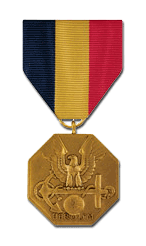
The Navy and Marine Corps Medal is the second highest non-combatant medal awarded by the United States Department of the Navy to members of the United States Navy and the United States Marine Corps. The decoration was established by an act of Congress on August 7, 1942.
Criteria
The Navy and Marine Corps Medal may be awarded to service members who, while serving in any capacity with the Navy or Marine Corps, distinguish themselves by heroism not involving actual conflict with an enemy. Typically, it is awarded for actions involving the risk of one's own life.
During the mid 20th century, the Navy and Marine Corps Medal has been awarded instead of the Silver or Gold Lifesaving Medal, for sea rescues involving risk of life. This is due primarily to the creation of a variety of additional military decorations that are often considered more prestigious than the Lifesaving Medal.
History
The Navy and Marine Corps Medal was first bestowed during the Second World War, although the first recipient is unknown. Perhaps the most famous recipient of the Navy and Marine Corps Medal was President John F. Kennedy who was awarded the Navy and Marine Corps Medal for service as Commanding Officer of a World War II Motor Torpedo Boat PT-109.
The Navy and Marine Corps Medal is generally considered the equivalent of the U.S. Army Soldier's Medal, the U.S. Air Force Airman's Medal, and the Coast Guard Medal.
Wear
Obverse
In the center of a bronze octagon one and a quarter inches wide, an eagle facing to its right, its upraised wings truncated by the edge of the medal. The eagle is perched upon a fouled anchor with the flukes beneath the eagle's right wing. Beneath the anchor is a globe. The inscription, HEROISM appears in raised letters at the base of the medal. The shape of the medal and the central theme of an eagle with displayed wings were suggested by the Soldier's Medal (the Army's counterpart decoration which was established sixteen years earlier). The anchor represents naval service, and the globe is from the Marine Corps insignia and represents that service. The inscription denotes the category of service for which the Navy and Marine Corps Medal is awarded.
Reverse
The reverse of the Navy and Marine Corps Medal is blank, that space being used for inscribing the recipient's name.
Ribbon
The ribbon to the Navy and Marine Corps Medal consists of three equal stripes of Navy blue, old gold, and scarlet, in that order. The blue and gold are the Navy's colors and the scarlet and gold are the colors of the Marine Corps.